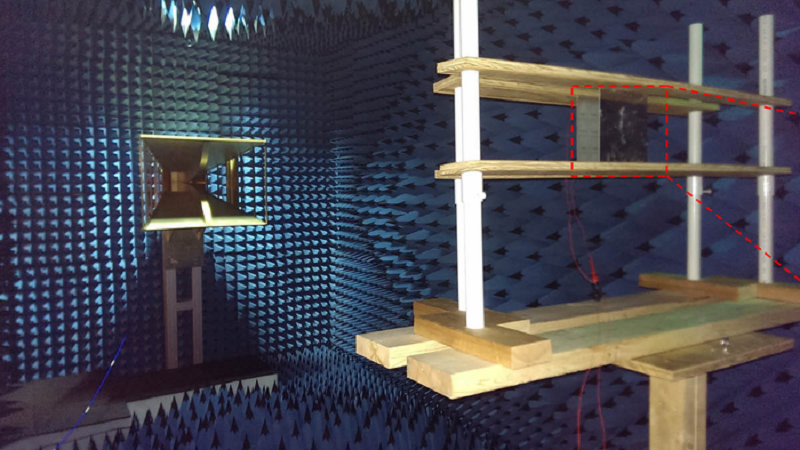
The researchers tested their metamaterial-based antenna in an anechoic chamber. The radio wave is sent out from the horn antenna on the left and received by the metasurface antenna mounted on the wood frame on the right. The anechoic chamber eliminates background signals from other sources and prevents stray signals from the radio wave source from bouncing around the room and perturbing measurements. The image of metamaterial-based antenna is enlarged on the right.
Radio emissions from mobile phone networks could be captured to wirelessly power sensors and other electronic components
While energy harvesting technology is still in its infancy, it is a fascinating subject. To use components to scavenge things like solar energy and vibration and from the environment and convert it into electrical energy to power components and circuits seems quite satisfying. Even though the process replicates what we do on a much higher scale for renewable energy, there is something quite unique about it. Maybe it is the ability to capture that energy and use it at almost the atomic level that is fascinating.
Advances in the technology are definitely coming at the correct time. The Internet of Things (IoT) is getting firmly established in all our lives. The concept relies on billions of sensors taking measurements from our bodies, our machines, our homes and every other area of out lives and our environment. These sensors have to be powered, whether that is from the mains, batteries, or by scavenged energy. As those sensors will be used in remote locations, mains power would be unsuitable for the majority of applications. Typical batteries would be physically too large, and smaller ones wouldn’t have the capacity to leave the sensors deployed for any length of time. As the location of the sensors may be difficult to access to change the batteries, energy harvesting, either on its own, or with a smaller rechargeable battery is the ideal solution.
In the latest published advance, researchers have designed a new metasurface-based antenna that takes us a step forward in the quest to practically harvest energy from radio waves. “By eliminating wired connections and batteries, these antennas could help reduce costs, improve reliability and make some electrical systems more efficient,” said research team leader Jiangfeng Zhou from the University of South Florida. “This would be useful for powering smart home sensors such as those used for temperature, lighting and motion or sensors used to monitor the structure of buildings or bridges, where replacing a battery might be difficult or impossible.”
The new antenna can harvest 100μW of power, enough to power simple devices, from low power radio waves. This was possible because the metamaterial used to make the antenna exhibits perfect absorption of radio waves and was designed to work with low intensities. Lab tests of the device, which measured 16 cm by 16 cm, measured the amount of power harvested while changing the power and frequency of a radio source between 0.7 and 2.0 GHz. They demonstrated the ability to harvest 100μW of power from radio waves with an intensity of 0.4μW per cm2, approximately the level of intensity of the radio waves 100 meters from a cell phone tower.
Capturing radio waves has previously proven difficult to generate enough energy to be useful. This is changing thanks metamaterials and the growing number of ambient sources of RF energy available, such as cell phone networks, Wi-Fi, GPS, and Bluetooth signals. Metamaterials use small, carefully designed structures to interact with light and radio waves in ways that naturally occurring materials do not. To fabricate the energy-harvesting antenna, the researchers used a metamaterial designed for high absorption of radio waves and that allows a higher voltage to flow across the device’s diode. This improved its efficiency at turning radio waves into power, particularly at low intensity.
The researchers are currently working to make the device smaller, while attempting to make a version that could collect energy from multiple types of radio waves simultaneously to allow more energy could be gathered.
C. Fowler, S. Silva, G. Thapa, J. Zhou, “High Efficiency Ambient RF Energy Harvesting by a Metamaterial Perfect Absorber,” Opt. Mater. Express Vol. 12, Issue 3, pp. 1242-1250 (2022)
https://doi.org/10.1364/OME.449494